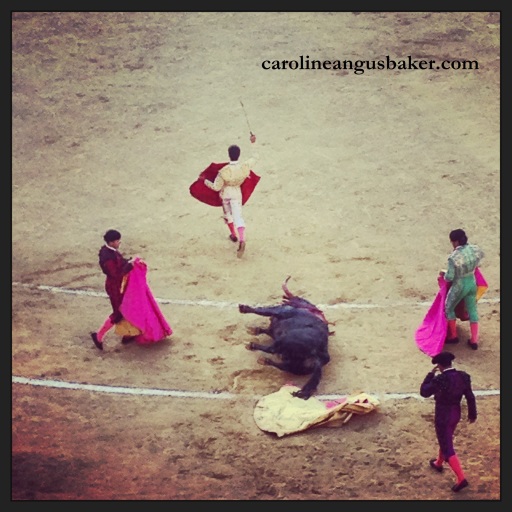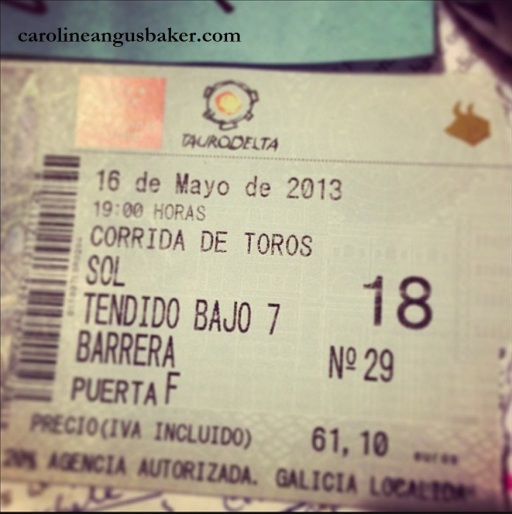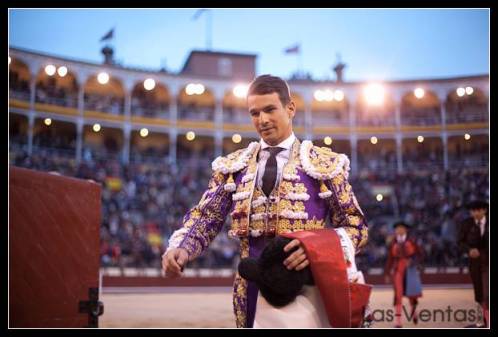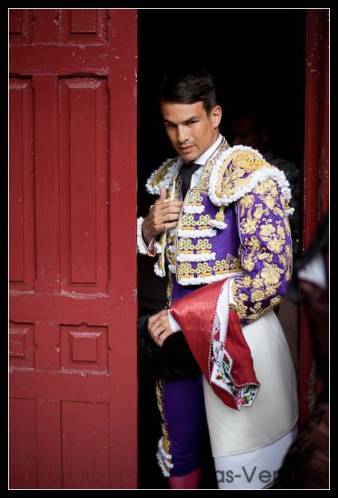“Bullfighting is the only art in which the artist is in danger of death and in which the degree of brilliance in the performance is left to the fighter’s honor.”
– Ernest Hemingway, Death in the Afternoon
Hemingway sung of praises and pitfalls in Death in the Afternoon. Generations past flocked to the ring. Protestors now stand outside the bullring and argue, as if they can change the minds of those going inside. Some people screw their faces up at the very notion of watching a bullfight.
The first time I was offered a slice of afternoon death in 2005, I didn’t flinch. I didn’t protest, I didn’t go on the offensive. From a young age I ran around on my nanny’s farm, probably terrifying the animals that we loved, fed and named. I also stood with a straight face the day I saw them slaughtered and turned into steaks, lamb chops or bacon strips. That is how the world works. Every animal you have ever eaten was killed, it lay bleeding out before cut up nicely for city folk to buy in little portions.
However, there is the fact that bullfighting taunts the animal before it meets its (hopefully) swift and bloody end. People who have never been to a bullfight can be very vocal of their opposition. That’s fair enough – I don’t need to watch child porn to know that I am steadfastly against it. Those who support bullfighting say it’s a tradition, part of Spain’s culture. Bullfighting is not considered a sport; rather it appears in the art and culture pages of the Spanish papers. I have studied and followed bullfighting in an attempt to learn more whilst writing the art into the storyline of my Secrets of Spain series. No matter how much you discuss bullfighting, no matter your opinions, an afternoon at the plaza de toros can have an effect.
“Bullfighting is like dancing the tango. It is a collection of human emotions – passion, love, anger, jealousy, happiness… all illuminated distinctly in the performance” – Cayetano Beltrán, Blood in the Valencian Soil
With the storyline of my second novel in the Secrets of Spain series, there are fights in both Valencia and Madrid. As the main character is the top billing at Las Ventas, the Madrid bullring, for San Isidro, a premier fiesta in the city, I decided to coincide my Spanish road-trip with this event. I booked a front row spot four months in advance, and lucky thing, because it was a sell-out. I wanted to look the animal in the eye and see how it feels down against the barrier.
To my surprise (or forgetfulness) there was also a one-off bullfight in Valencia for the Virgen de los Desamparados fiesta. Return to the same ring that I had been given tickets to in 2005? Why not? Suddenly my trip had two bullfights – and they couldn’t have been more different.
Valencia – the cheap seats
I got a seat right at the very back, very top, very last spot of the bullring. If you’re unsure about bullfighting, then this is the place for you. Up high, looking out over the entire ring, you are wholly disconnected from what is happening on the sand. What else could you expect for €15? In saying that, the enthusiasm from my fellow spectators wasn’t diminished. All men, aged over 60, with fat cigars in their hands found it amusing to help a woman find her seat. Poor hapless girl needs help from a Spanish man. (Hey, okay, enjoy while it lasts, dudes. Lung cancer can’t be far away!)
The ring was half empty, but those who had made the trip were keen to see three toreros (or matadors if you’re Anglosaxon), each having two fights. Here’s a very basic rundown of how it works, starting with the pasodoble played with a band headed up by a trumpet.
Out they come in Madrid
A torero isn’t alone, he has a cuadrilla (entourage, if you will). To start with his three banderilleros (let’s call them pink cape guys in full dress), taunt the bull a little, allowing the torero to get a look at the animal, how it moves, etc. This is a bit of entertainment; the pink cape guys tease the animal, let him run around, get nice and angry. The torero can come in and do what is called the suerte de capote (act of the cape), making passes with the animal. This is the fun thing about bullfighting. When the torero gets it just right, the crowd all let out a ‘ooooh’ at the same time, me included. You don’t need to understand passes (like the veronica, where the torero holds his posture as the bull goes under the cape) to know when it’s done well. It’s like watching a flawless ballet dancer and you can see the gracefulness in the moves. You don’t need to know how to do it to know it’s being done well.
Banderilleros in Madrid
Next is the bit I find a little pointless, other than the bloody great point on the end of the lance, that is. In come two picadores (guys with lances on horseback). The horses are very well padded and have their eyes covered. They appear calm, but if you think they are innocent to the situation, I reckon that’s bollocks. Horses are too intuitive for that. Anyway, the bull is suitably pissed off and charges the horses, and the picador jabs his lance into the muscle at the back of the bull’s neck. It’s bloody, meaty and weakens the angry animal.
Picador gets his lance in the bull in Madrid
Then comes some more taunting, when the three banderilleros attempt to stab multi-coloured banderillas into the neck of the beast. Whether you like bullfighting is irrelevant when assuming that you need to be pretty brave to give it a try, because the bull is mad by this stage and ready to gore you in the guts.
España coloured banderillas in Madrid
Next is the real action, the tercio de muerte. In comes the torero alone with his red cape and his sword. The torero makes a number of passes with the bull, attracting it with the movement of the cape (bulls are colour-blind) and allowing it to charge past him at close range, the closer the better. (Time for more ‘oooohs and olés’) The graceful movement comes into play and it’s great to see those smooth and precise movements if they get it right.
José Maria Manzanares can get it right
While you’ll be hearing a few “¡oles!” at this point, the crowd need to shut up for sword time. In theory the torero rams his long sword in cleanly (called the estocada) and the animal falls and dies. The beast has been pieced in the heart, the aorta severed. The whole faena should be done in about 20 minutes.
The final bull dies in Valencia
That’s all fine and well, if it works. I watched the full six fights in Valencia, and some were better than others. Unfortunately, the sword didn’t always go in, and it took several, what I would imagine as painful, attempts to sever the heart. All bulls get a puntillero, a dagger, jammed in to make sure they’re really dead. In some fights, the bull had the sword inserted and it stumbled around before dying. That is jeered by the crowd (at the torero, not the bull) and it does highlight the unfairness of the performance. The Valencian crowd (in a half-filled ring) were treated to three reasonable fights, two less than impressive performances, and one I have to admit was well done, with clean passes and a single blow with the sword. That was the only beast that appeared to die right away. In response, the crowd did the customary waving of white handkerchiefs, the indulto, to show their support to have the torero awarded an ear before the check-its-dead-dagger is inserted. Yep, an ear cut from the animal and handed to him in all it’s still warm and bloody glory. At least we got one ‘good’ performance! A torero can be awarded up to two ears and/or a tail.
A very dead bull gets removed Madrid. I have picture of it being removed and sliced up, but decided not to post it
~~~
High times in Madrid
Onto Madrid and Las Ventas for the sold-out San Isidro fights. Wow, what a difference! Once the toreros all came in, they held one minute’s silence for José Gómez Ortega, or Joselito, who was gored to death in Talavera de la Reina aged 25, in 1920. It was his idea to have a premier ring built in Madrid. One humorous moment came during as entire 25,000 sell-out crowd stood in silence. About halfway through, a lone voice cried out “Viva España!” The crowd erupted into wild cheering and clapping, which appeared to make the Police in front of me a little nervous. It eventually died down and we had to start the silence all over again.
Time for silence and prayer
Madrid was cold. Cold on a level I don’t care to enjoy in Spain. The uncharacteristic weather certainly made it hard to enjoy my time on my concrete seat, though the barrier directly in front of me did provide some shelter from the wind. I was blessed with a seat in the sun and I needed every drop I could get! The guy next to me had frozen his way through the fights the previous night in the shaded area, but the problem was that the sun was already beginning to fade. However, as the sun sets and the lights come on, the torero’s suit, traje de luces, glitter and sparkle which is rather beautiful all on its own.
This is how I see it – anyone could sit in the Valencian sunshine and watch from above. Even someone who doesn’t feel happy about animal killing could cope. Sitting in the front row at Las Ventas gives a far more real experience of the situation. The first bull ran out and I sat close enough to be able to see the bull. It seemed genuinely afraid, lost and confused. You imagine the bull to be angry and this beast was not. As the dance of taunting began, I sat shivering (and politely rebuffing all the coats from gentlemen twice my age. Gracias, caballeros, muy amable) and felt really sorry for this bull. Once the horses had come and gone, the lances were removed from the ring. The guys carrying the weapons stopped right in front of me, giving me the chance to see the spears covered in blood and flesh. I wanted up close, and I got it!
Preparing for a bull in Madrid
Six fights – and none of them spectacular. To be honest, it can get very repetitive very quickly. For those who thoroughly watch the events and can pick subtle differences, I’m sure it felt different, the same way others find yachting boring when I’m into the action. One thing I noticed in Valencia was that after the first round, many people, primarily tourists, got up and left. Las Ventas – not so. In fact, because I entered the ring early (and thanks to the strapping young chap who accompanied me to my spot and asked me out on a date) I had a chance to watch the crowd. Around a third there were women, a big difference to Valencia, and the average age of the crowd was much younger than Valencia (though not in the prime seats).
Not all the bulls seemed as nervous as the first, some charged out and were keen to get their horns caught in the wooden barrier in their quest to catch a torero or two. Still, when up really close, you not only see but can hear the animal panting. Its tongue, which hangs and drips as the animal tires, quivers with every laboured breath. The further through the faena the bull progresses, the more it begins to moan and grunt, something you don’t hear in the cheap seats. At times, the toreros yelled to the bull to get its interest, as it look bored and exhausted. There were moments when the animals were fired up and ready to hurt someone; the risk is certainly there. But often it looked like a tired animal who really couldn’t give a damn.
This bull wanted some action
“The animals are brave, noble, and majestic. While it would be a disgrace to allow the bull to live at the end of its performance, it dies with consummate gallantry. He bursts through the gate of fear into the ring and is powerful against the torero.” – Paco Beltrán, Vengeance in the Valencian Water
Seconds from death as in goes the sword
I don’t mean to sound critical of any of the fighters I saw in either Valencia or Madrid. I’ve poked bulls with sticks and run through their paddocks as a kid, but I wouldn’t want to jump in that ring! There is not just the wrath of the bull, but also of the audience. When the crowd became tired of the time taken to kill the bull, they didn’t hold back in criticism. When the sword didn’t go in cleanly (and that was a lot in Madrid) the crowd jeered, me among them. The thing I learned above all else is that the true beast is the crowd, who urge for the kill. The bull and the torero are puppets in a game of cultural bloodlust.
What did I get out of going to bullfights? In the case of Valencia, not a lot. Judging by the crowds, you can tell it’s not a quintessentially Valencian pastime. Many there were tourists (and there’s a lot of those in V-Town these days), and the place was half empty. Luckily, for my efforts, I got to see a good clean death and and ear awarded (if you consider that good).
In the case of visiting Las Ventas, I got a lot for writing. When Cayetano Beltrán steps out onto the sand in Vengenace in the Valencian Water, to face off against the ghosts of Las Ventas, I’m going to know how it feels to be there, at the barrier, watching him. I don’t doubt the men who take on the bulls, they love it and believe in what they’re doing. There are more men wishing to become toreros than in the past thanks to the recession (so they tell me). I don’t wish to sound negative about their talents, performances or desires to maintain this Spanish tradition.
Is the whole process cruel to bulls, even though they were lovingly bred for this exact purpose? Yes. I don’t see the value in killing for entertainment, and I didn’t think I would feel as strongly about that as I do now. While I respect the rights of those who participate and support, I have no need to ever go back. I didn’t expect to have a feeling of disappointment as I left Las Ventas. Will you ever see me at the plaza de toros in the future? Maybe, who knows. I’ve had my day at the barrier, and I have many feelings and thoughts to savour and translate into novels, but not all of them good.
Once back in ‘my’ part of Madrid for some quiet (or not-so quiet) vermouths, I discovered that I had missed the protest against Franco and his wartime slaughtering of Republicans. I would have much rather have been in Puerta del Sol, holding a sign with the face of a loved one attached, one of the ‘disappeared’, as that is in my Secrets of Spain series and close to my heart. A little bit of my ancestral blood is somewhere in Spain’s soil, hidden away. At least that’s one thing I can write in the series without the need to go looking for it. Some people are holding up tradition at the bullring, and some are fighting for Spain’s past and future. Either way, Spain may be suffering economically, but its soul is as alive as ever.
Un beso muy grande y gracias to a very (handsome in purple) helpful and inspirational torero – José Maria Manzanares
Watch the video replay of Las Ventas 16 May – San Isidro 16.5.13
Visit Las Ventas website – Las Ventas
Up next… A Little Jaunt to Spain – Part 7 – Valle de los Caídos: Spain’s most terrifying location (prepare for some strong opinions now)
Click here for past installments – Spain 2013 in Review series




















I’ve never been to a bullfight, Caroline, so I can’t speak from experience, but I thoroughly enjoyed reading your article. It explained many of the”mysteries”, and has maybe even given me the courage to go and have a look for myself.
I would say, in general, I’m opposed to bull-fighting, but am I really entitled to such an opinion without witnessing the spectacle? Hmmmm …..
Very well written. Thank you.
LikeLike
Hi, Caroline, I hope you don’t mind, I’ve used one of your photos in my blogpost here: http://www.ourrelationshipwithnature.com/?p=356
I was fascinated by your post – you’ll see why if you read mine! I’ll keep an eye out for your books, too. Good on you for seeking reality in your research.
Buena suerte!
LikeLike
No problem, I love sharing photos. I like your article, a great insight into both sides.
LikeLike